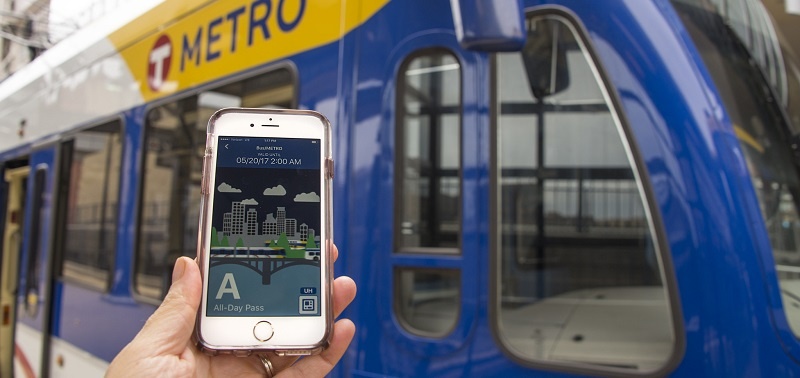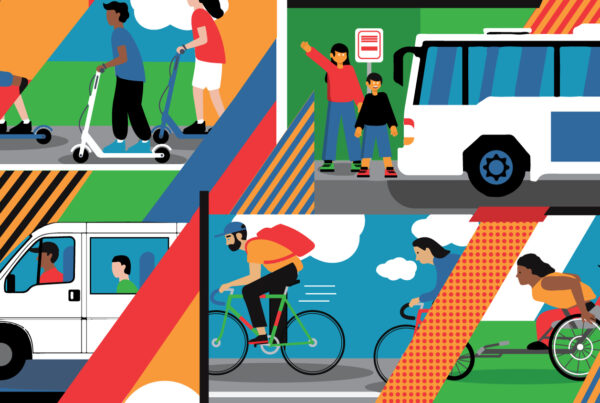To the consumer, using an integrated transportation app to track a train or hail a ride may seem like no big deal. But a successful application requires major back-end coordination, often across multiple departments and sectors. Add integrated payment and varied funding sources, and the bar to success becomes even higher.
However, that’s not stopping public and private transportation providers from pursuing a Mobility as a Service (Maas) model. MaaS integrates all the travel options available to a user and offers them in a single interface, with a single payment mechanism. Or, to borrow from Cubic’s Andy Taylor, it is a “combination of public and private transportation services within a given regional environment that provides holistic, preferred and optimal travel options, to enable end-to-end journeys paid for by the user as a single charge.”
Taylor recently joined the Shared-Use Mobility Center (SUMC) and several other leading public and private sector experts for a webinar on App-Based Solutions for an Integrated Transportation Network. The webinar’s speakers included:
- Sharon Feigon, Executive Director, Shared-Use Mobility Center
- Regina Clewlow, VP of Business Development, Swiftly
- Bibiana McHugh, IT-GIS Manager, TriMet (Portland, OR)
- Adam Mehl, Market Development Specialist, Metro Transit (Minneapolis-St. Paul)
- Andy Taylor, Director of Strategic Initiatives, Cubic
The webinar covered a wide variety of challenges and best practices for implementing MaaS. Here are a few take-aways:
- Money Matters: Getting the Funding, Securing the Stakeholders
Mobile app development is not free. It also requires the efforts of a dedicated, knowledgeable staff. So where can agencies secure funding for such projects? To develop a new mobile app with MaaS features, Metro Transit’s Adam Mehl said his agency was able to draw from federal Congestion Mitigation and Air Quality (CMAQ) funding.
Speakers also offered a range of options that agencies might leverage, such as pilot project funding streams (e.g. the Federal Transit Administration MOD Sandbox program), funds from ballot measures, public-private partnerships (P3s), advertising and marketing agreements and use of savings from the capital/infrastructure side, as well as other traditional funding sources.
- Ensure Access to Real-Time Information
The cornerstone of a successful MaaS-ready app is the tool’s ability to provide reliable information in real time. In addition to the broader MaaS discussion, Andy Taylor joined Swiftly’s Regina Clewlow in stressing that, for users to stay with an app, all passengers need to have access to complete travel information—for all routes and modes, in real time (not just notifications of delays). This information should also be accessible to developers.
Bibiana McHugh, who helped develop the now-standard General Transit Feed Specification (GTFS), is directing TriMet’s efforts to develop open-source trip-planning software that agencies might easily replicate and integrate into MaaS-friendly apps. TriMet has hosted hack-a-thons with its data to try to improve functionality, which has helped with debugging and adding additional features.
Clewlow emphasized that users with vision issues or without smartphones should still be able to easily access the features of a good transportation planning app. Her company has developed parallel telephone and text functionalities to serve these and other customers.
Finally, while travel information should be as open and accessible as possible, the same cannot be said for another component of MaaS—the payment system—given the sensitive nature of user and financial information.
- Move Toward Integrating Multiple Fare Systems
By using an integrated, single-fare payment system, a MaaS service can allow users to pay for a complete trip all at once, regardless of transfers within or between modes. Early fare-integration programs, such as Seattle’s ORCA and Chicago’s Ventra, allow users to buy tickets for multiple agencies using one farecard or app. Neither app has yet realized complete, seamless functionality, but the goal is to replicate the single-card model within the app. Mehl also discussed integrating fare payment into Metro Transit’s app. While fare payment was not initially a planned feature of the app, it is now a “showcase feature” that can reduce cash handling at the farebox and speed up bus boarding.
A successful MaaS system requires complex legal and financial coordination that varies by jurisdiction, but there’s no doubt the demand for such a product exists, and the concept is being explored by a wide range of providers. Agencies interested in pursuing MaaS may want to consider other cities’ experiences for examples of the workflow required to implement a MaaS system.
Examples of Existing Programs
The presenters discussed a range of existing early-stage MaaS programs. Examples included:
Go Denver App
City: Denver, CO
Date: February 2016
The City of Denver partnered with Xerox to launch the Go Denver app, which allows users to search for the best route to their destination using multi-modal transportation options. The app also allows users to choose between the quickest, cheapest, or least carbon-intensive route to their destination. Besides traditional public transportation, the app lets the user choose from among walking, biking, and driving as well as shared mobility services such as Lyft and Zipcar.
Divvy Bikeshare-Transit Fare Integration
City: Chicago, IL
Date: October 2016
The Chicago Transit Authority received a $400,000 grant from the Federal Transit Administration, through the Mobility On Demand Sandbox program, to modify the existing Ventra app to allow users to more easily access Chicago’s Divvy bikeshare system. The new features will allow Ventra users to locate Divvy bike share stations, view bike and dock availability, and seamlessly pay for Divvy passes through the app using Ventra transit value.
TriMet Open Trip Planner
City: Portland, OR
Date: 2017
TriMet has plans to partner with several organizations, including Conveyal and IBI Group, on its Open Trip Planner Shared-Use Mobility pilot program. The pilot aims to create a platform that integrates transit and shared mobility options to enable seamless, multimodal trip planning.
ORCA (One Regional Card for All) Fare System
City: Seattle, WA
Date: 2009
The Seattle area successfully integrated payment systems from across the region into the ORCA Card. A report on the Central Puget Sound Regional Fare Coordination Project explores the feasibility of the integrating the fare systems of King County Metro Transit (the largest agency), Community Transit, Everett Transit, Kitsap Transit, Pierce Transit, Sound Transit and the Washington State Ferries. A single fare card (implemented as ORCA-“One Regional Card for All”) allows users access to any of the partner organization’s facilities. The report outlines the necessary backend measures necessary for successful implementation, including partnerships with contractors.
Metro Transit Mobile Application
City: Twin Cities, MN
Date: 2014
Metro Transit used a Congestion Mitigation and Air Quality (CMAQ) grant to fund the development of a mobile app with the aim of improving access to transportation information, providing an integrated view of transportation options, increasing the number of residents and visitors using public transit, and as a tool to collect travel patterns to improve planning. The proposal was funded in 2014 for $300,000, covering 80% of the mobile app development costs.
MetroLINK’s TransLoc Rider App
City: Quad Cities, IA-IL
Date: 2017
Quad Cities MetroLINK and TransLoc have partnered to develop a new transit app for the Illinois Quad Cities community. As of March 7, Metro bus riders can use the TransLoc Rider app to look up bus schedules, access route information, and receive trip notifications and other service alerts. With this app, riders will be able to get real-time bus information to better know when and where the bus they need will arrive.
More information on these and other case studies is available in SUMC’s Shared Mobility Policy Database, now home to more than 800 relevant policies, plans, RFPs and more. You can also view the speakers’ PowerPoint presentations and access the recorded webinar here.
Finally, to learn about future SUMC webinars and receive our weekly shared mobility newsletter, don’t forget to subscribe to SUMC’s mailing list.
Image credit: Metro Transit


